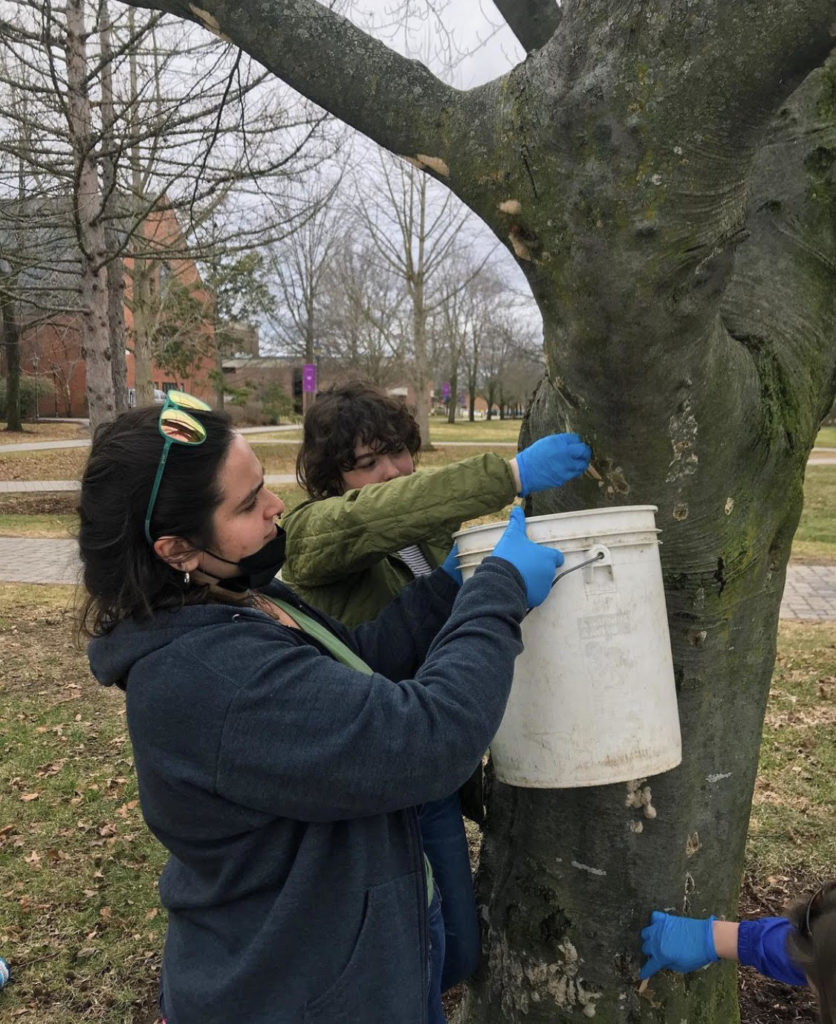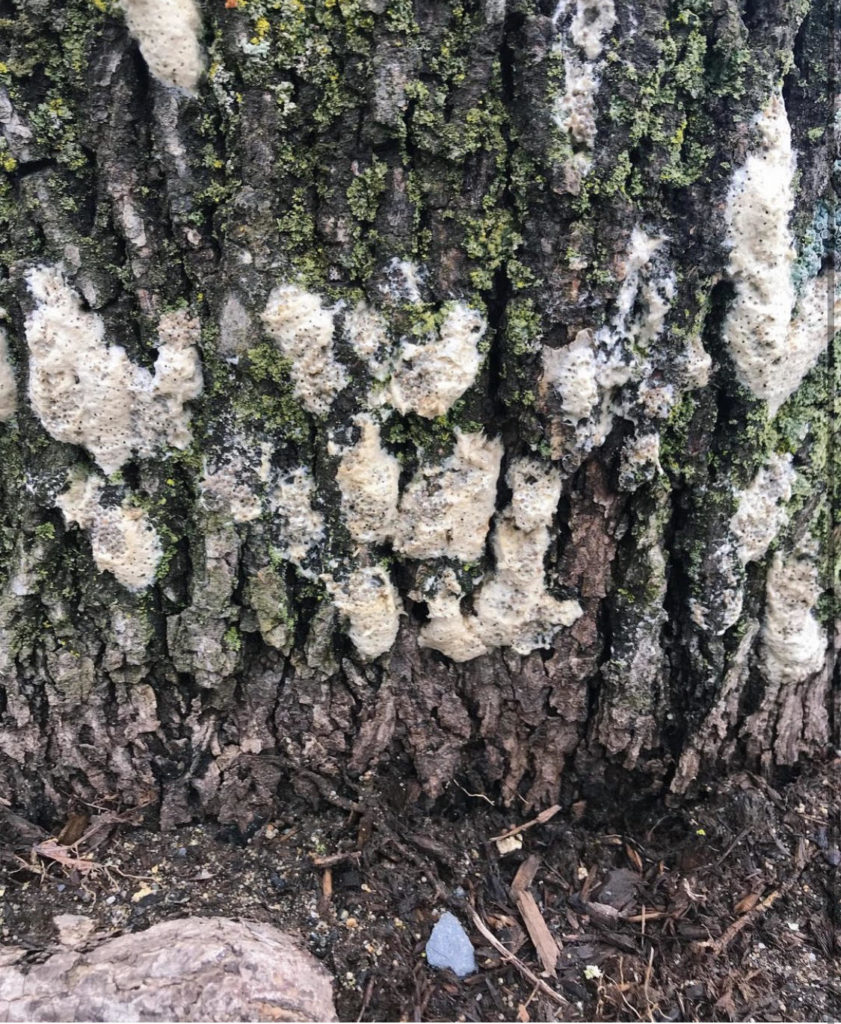Ally Achorn | Staff Writer | aachorn@mail.smcvt.edu


Photos courtesy of: Carly Broome
With a popsicle stick in one gloved hand and soapy water in another, a group of six student-volunteers removed potentially harmful spongy moth eggs from trees around Main Campus on April 8. They scraped off as many spongy consistency eggs as they could from reachable areas of most campus trees.
“We just really wanted to focus on the trees that we can see around our townhouses and our living spaces and the academic buildings and things like that,” said Anna Beach ‘22.
Beach is an environmental studies major and a Outdoor Volunteer Efforts Leader. She also volunteered and led the removal initiative.
Spongy moths are present throughout New England. They are an invasive species that feeds on leaves from a variety of trees. They have been known for defoliation, or eating all the leaves off of trees, leaving plants barren and weak when early summer arrives.
“For us, recently, we haven’t had an outbreak of spongy moths in 30 years,” said Josh Halman, forest health program lead at Vermont Department of Forests, Parks & Recreation.
“Last year was the first time we saw significant defoliation anywhere in the state in the last 30 years. By the end of the summer, we had over 50,000 acres of defoliation,” he said.
The rise in spongy moth growth has caused a massive defoliation of trees.
“The unfortunate thing is because there was such a successful year for spongy moths last year, they were very successful in laying eggs as well, and so the numbers of egg masses that we’re seeing in the plots that we’ve monitored for years, are elevated even compared to last year,” Holman said.
The egg masses have been very apparent on campus according to Beach.
“A birch tree near McCarthy was just completely coated in them,” said Thomas Bemis ‘25, volunteer and member of Green Up. Green Up is a club on campus that focuses on environmental sustainability, conservation, and restoration

In the past, the spongy moth population control has been regulated because of a fungus called Entomophaga maimaiga. The fungi consumes caterpillars as nutrients.
“Typically what happens is there’s a fungus that knocks back the caterpillars and when you have a dry spring, the fungus doesn’t do so well,” said Declan McCabe, biology professor and entomologist at St. Michael’s College.
According to the 2021 Vermont Insect and Disease Condition Report, Vermont was in the midst of a drought that affected necessary growing conditions for fungi to grow.
Western Vermont experienced the most deforestation, mainly in Chittenden, Addison, Franklin, and Rutland counties.
“Colchester got hammered and based on the egg masses I saw there, it’s quite likely to experience serious defoliation again,” said Judy Rosovsky, a state entomologist with the Vermont Agency of Agriculture, Food and Marketing.
When tree leaves are eaten, they are unable to create the energy it needs to survive. Trees tend to store extra energy, but the use of that energy significantly decreases the ability for the tree to survive. It is similar to how a person can survive off their stored fat, but they become significantly weaker and fall ill. This energy use causes stress on the tree just like the human body.
According to McCabe, many of the trees last year were able to produce a second growth of leaves later in the season. However, if the trees experience a second year of defoliation, it’s possible that many trees on campus could die
This year, there may be a surplus in the amount of spongy moth eggs on campus and around Vermont, but the weather conditions this spring project good prospects for fungus growth. The 2021 Vermont Insect and Disease Condition Report explained that Entomophaga maimaiga prefers wet and/or humid weather conditions to spawn.
“If we have a wet spring, at least we don’t have to worry about the trees being stressed,” Rosovsky said.
With student volunteers scraping off larvae, St. Michael’s College is already ahead to minimize the amount of deforestation the spongy moths will cause on campus. For the students, this project was not just a simple task, but provided outdoor volunteer opportunities that helped create environmental change.
“I feel like a lot of the time with environmental issues, some of them are just so big. I guess you can also say, including the spongy moth, it’s a big problem,” Beach said. “Sometimes we don’t think we have the capacity to respond in a way that will significantly contribute to the solution, but I think it’s really important to keep that in mind that it’s a bigger problem, and one person can’t solve it. I think we had the obligation to like, respond in some way.”
Spongy moths may be a problem on campus, but they are not the only environmental issue out there. When students take the lead through clubs like Outdoor Volunteer Efforts and Green Up or on their own, they can make an impact on the environment and the community they serve.
According to the student volunteers, spongy moth eggs and other invasive species are always going to be present, but with small efforts like these, it can make a huge difference in balancing the ecosystem.

